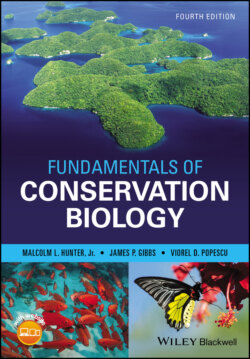Читать книгу Fundamentals of Conservation Biology - Malcolm L. Hunter Jr. - Страница 109
An Important Caveat
ОглавлениеIt must be emphasized that the equations presented in this section provide only estimates of the likely effects of processes that diminish genetic diversity. Exceptions may be fairly common. For example, Indian rhinoceros appear to have retained a high level of genetic diversity despite having passed through a serious bottleneck, perhaps because of high mobility of some individuals and long generation times (Dinerstein and McCracken 1990). The same applies to Chilean blue whales (Torres‐Florez et al. 2014) likely for the same reason: both rhinos and blue whales are long‐lived animals. Similarly, an isolated population of pinyon pine (also very long generation times) retained its genetic diversity over 300 years (Betancourt et al. 1991).
Even if the predicted effects on genetic diversity occur, they may not have catastrophic consequences for a population. For example, the northern elephant seal was reduced to as few as 20 individuals in the 1890s and now seems to have extremely low genetic diversity: no allozyme polymorphism at 24 loci from a sample of 159 seals from five colonies (Bonnell and Selander 1974) or at 43 loci from a sample of 67 seals from two colonies (Hoelzel et al. 1993). Despite this lack of genetic diversity, the northern elephant seal is now thriving with a total population approaching 200,000. The Mauritius kestrel also passed through a narrow bottleneck, just one breeding pair, that sharply reduced its genetic diversity, and has now recovered to over 200 pairs (Groombridge et al. 2000). In this case, examination of genetic material in museum specimens confirms that the original population was very diverse genetically despite being confined to a small island. Under special circumstances, passing through a bottleneck might have a positive effect by eliminating all the individuals carrying deleterious recessive alleles, thus purging these alleles from a population, something hermaphroditic mollusks, including highly endangered Hawaiian tree snails with high fecundity and the ability to self‐fertilize, may be capable of.
These may be examples of just a few lucky species that survived a bottleneck; the many other species that did not survive are not around to be studied and reported upon here. Even if there might be some benefits to inbreeding, they might be short‐lived if a bottleneck left the species so genetically uniform that it was ill prepared to adapt to future environmental change. That is a big concern for elephant seals and the Española Island giant tortoise we just discussed.
